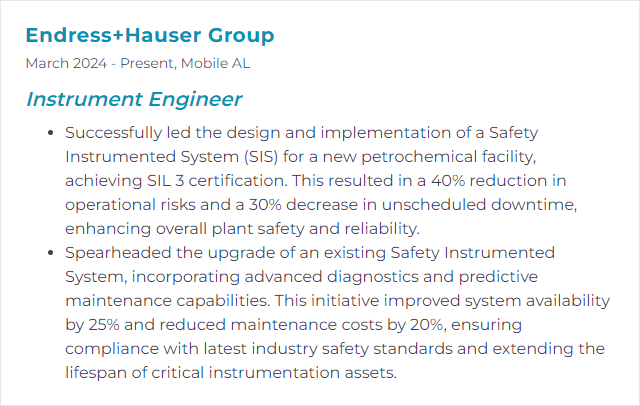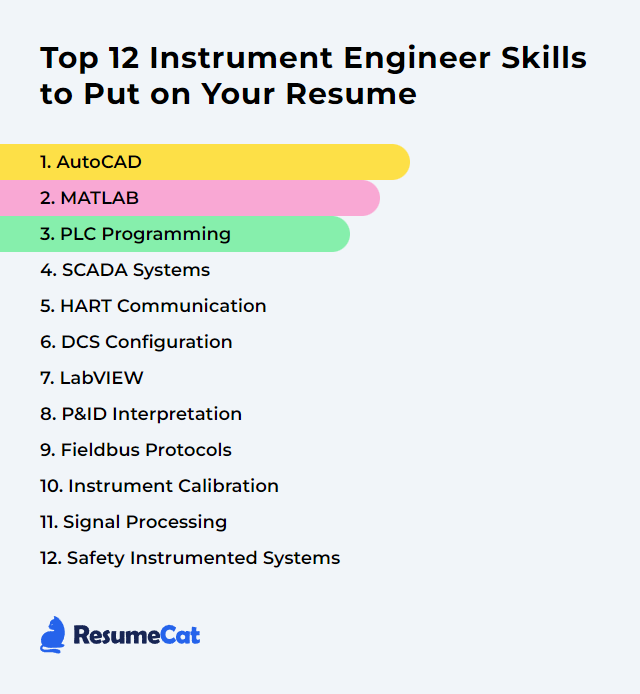Top 12 Instrument Engineer Skills to Put on Your Resume
In the competitive world of instrumentation engineering, getting noticed means showing a sharp mix of technical depth and on-the-ground pragmatism. The skills below help instrument engineers signal real capability—design savvy, operational fluency, and an instinct for reliability—so recruiters see immediate value and teams feel the difference.
Instrument Engineer Skills
- AutoCAD
- MATLAB
- PLC Programming
- SCADA Systems
- HART Communication
- DCS Configuration
- LabVIEW
- P&ID Interpretation
- Fieldbus Protocols
- Instrument Calibration
- Signal Processing
- Safety Instrumented Systems
1. AutoCAD
AutoCAD is CAD software used to produce precise 2D and 3D drawings and models for instruments, systems, and components. Instrument engineers lean on it for clean layouts, clash-free routing, and accurate documentation.
Why It's Important
It underpins exact design and drafting of complex instrumentation systems, enabling accurate planning, installation, and future modifications without guesswork.
How to Improve AutoCAD Skills
Focus on speed, precision, and repeatable workflows.
Master shortcuts: Keyboard commands shave minutes off every task; seconds add up.
Data extraction: Auto-generate instrument lists and schedules directly from drawings to reduce errors.
Custom tool palettes: Build palettes with your most-used symbols, layers, and blocks for instrumentation work.
Dynamic blocks: Create parameterized symbols (valves, transmitters, hookups) to standardize and move faster.
Templates and standards: Enforce layers, text styles, linetypes, and title blocks to keep projects consistent.
Stay current: New releases often bring annotation, PDF, and collaboration improvements worth adopting.
Community and training: Tap Autodesk forums, user groups, and advanced courses that target industrial design.
Put these habits into daily work and the software starts to feel lighter, more responsive, almost invisible.
How to Display AutoCAD Skills on Your Resume
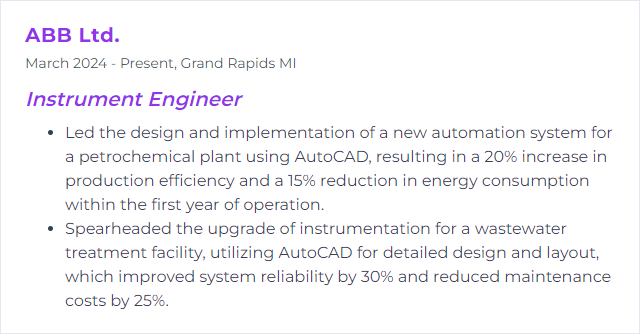
2. MATLAB
MATLAB is a high-performance environment for computing, analysis, and visualization—ideal for instrument engineers modeling systems, digesting data, and building quick simulations.
Why It's Important
It accelerates analysis, design, and testing for complex instrumentation and control problems, turning raw data into decisions.
How to Improve MATLAB Skills
Core fluency: Vectors, matrices, indexing, plotting—get muscle memory for the basics.
Data visualization: Craft clear plots and dashboards that make anomalies obvious and trends speak up.
Signal processing: Use the Signal Processing Toolbox to filter noise, detect features, and validate measurements.
Automation: Replace repetitive steps with functions, scripts, and live scripts.
Instrument Control Toolbox: Connect to instruments directly, log data, and script test sequences.
Simulink: Model multi-domain systems and test control logic before touching hardware.
Community resources: Explore MATLAB Central for examples, answers, and best practices.
Practice: Solve real problems—use plant data, build a quick model, iterate.
Courses and certifications: Programs on major learning platforms sharpen skills quickly.
Consistency matters. Small projects, week after week, compound into mastery.
How to Display MATLAB Skills on Your Resume
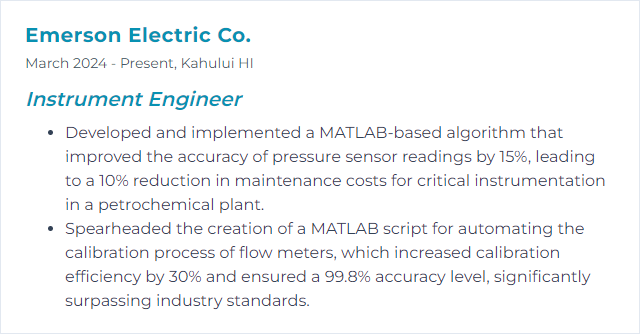
3. PLC Programming
PLC programming builds the logic that automates machines and processes—ladder, function block, structured text—tying I/O, interlocks, and sequences into safe, predictable behavior.
Why It's Important
It drives precision, uptime, and safety. Without robust logic, plants stall; with it, they hum.
How to Improve PLC Programming Skills
Ground yourself in fundamentals: Scan cycles, I/O mapping, debouncing, latching, and state machines.
Learn by doing: Simulate and test with vendor tools; use hardware-in-the-loop when possible.
Modern environments: Work with Studio 5000 Logix Designer (formerly RSLogix 5000), TIA Portal, and other major ecosystems.
Design patterns: Standardize alarm handling, permissives, and fault recovery routines.
Code reviews: Peer reviews catch edge cases and sharpen style.
Community: PLC forums and user groups are gold mines for tricky troubleshooting insights.
Stay current: Track safety PLC features, diagnostics, and cybersecurity hardening guidance.
Build clean, commented logic with test benches and you’ll ship code you can trust at 2 a.m. during a hot start.
How to Display PLC Programming Skills on Your Resume
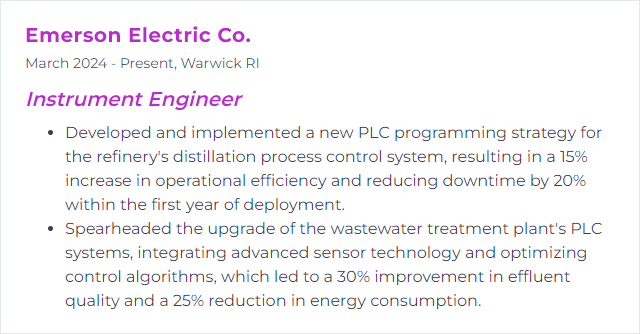
4. SCADA Systems
SCADA systems monitor and control processes across plants and remote assets, collecting data from sensors and instruments and presenting it for swift decisions and steady operations.
Why It's Important
They provide visibility, control, and history. Efficiency rises. Failures become events you see coming rather than surprises.
How to Improve SCADA Systems Skills
Strengthen security: Align with ISA/IEC 62443 concepts, apply least privilege, patch routinely, segment networks, and monitor.
Better data management: Use a plant-wide historian (such as the PI System) and define clear tag naming, deadbands, and retention rules.
Hardware health: Refresh aging sensors and RTUs, check calibration drift, and standardize on reliable protocols.
Redundancy: Redundant servers, comm paths, and power keep the lights on when things wobble.
Scalability and compatibility: Favor open protocols, modular architectures, and tested integrations with existing systems.
Training: Keep operators and engineers current on features, alarm philosophies, and security practices.
Enterprise integration: Integrate with MES/ERP where it makes sense so business decisions reflect real process conditions.
Treat SCADA like a living system—observe, update, refine—and it will return stability and insight.
How to Display SCADA Systems Skills on Your Resume
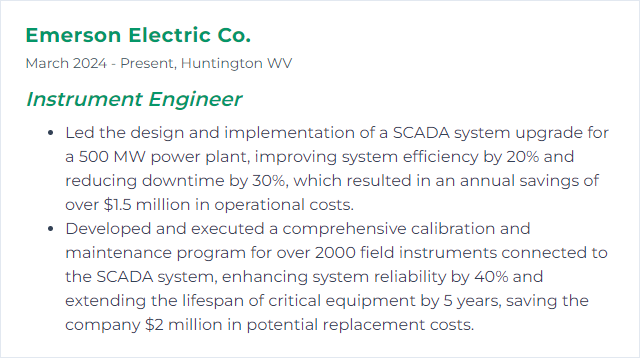
5. HART Communication
HART overlays a digital signal on the 4–20 mA loop, enabling two-way communication with smart field devices for diagnostics, configuration, and data access without disturbing the analog control signal.
Why It's Important
You get live diagnostics and configuration at your fingertips—fewer field trips, faster troubleshooting, and richer data without rewiring the plant.
How to Improve HART Communication Skills
Cabling and grounding: Use shielded twisted pairs, proper grounding, and keep distance from noisy conductors.
Device compatibility: Confirm every loop device is HART-capable and correctly configured.
Loop impedance: Ensure total resistance is at least 230 ohms; 250–600 ohms is typical for reliable modem communication.
Repeaters or multiplexers: For long runs or complex networks, add devices that preserve signal integrity.
Diagnostic software: Use vendor or third-party tools to scan device health, view DD/DTMs, and streamline commissioning.
Proper termination: Terminate lines appropriately to avoid reflections and distortion.
Updates and maintenance: Keep device firmware and DD/DTM files current; verify after plant outages or brownouts.
Training: Regularly refresh skills on commissioning, loop checks, and advanced diagnostics.
Clean wiring, correct impedance, current files—small details that prevent big headaches.
How to Display HART Communication Skills on Your Resume

6. DCS Configuration
DCS configuration sets up control logic, I/O assignments, graphics, alarms, and interlocks across a distributed system so processes run safely and efficiently.
Why It's Important
Well-structured configuration reduces risk, shortens commissioning, and makes operations predictable even under stress.
How to Improve DCS Configuration Skills
Assess and baseline: Audit current strategies, alarm rates, and graphics. Identify duplication, dead code, and brittle logic.
Standardize: Create libraries for loops, motor control, permissives, and trip logics. Enforce naming and documentation standards.
Modernize: Keep hardware and software supported; migrate legacy nodes and obsolete drivers.
Cybersecurity: Apply defense-in-depth, harden servers and workstations, and segment networks.
Analytics: Add performance dashboards and historian-driven KPIs to spot drift and instrument issues early.
Redundancy: Redundant controllers, networks, and power supplies prevent single-point failures.
Training and drills: Train operators and engineers on abnormal situations and change management.
Feedback loops: Gather operator feedback and use event logs to tune alarm limits, deadbands, and sequences.
Clarity in templates, discipline in change control, and relentless cleanup—that’s the game.
How to Display DCS Configuration Skills on Your Resume
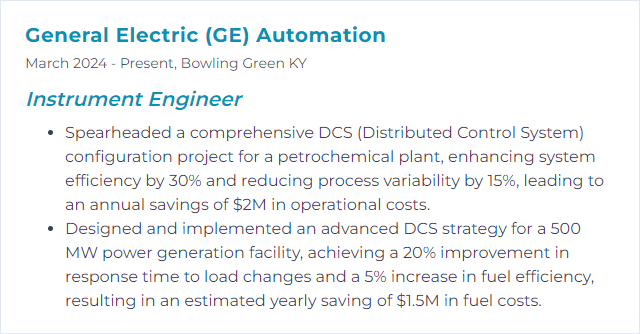
7. LabVIEW
LabVIEW is a graphical programming platform used to build automated test, measurement, and control systems—fast data acquisition, instrument control, and solid visualization.
Why It's Important
It lets you prototype quickly, integrate instruments without pain, and deploy dependable test rigs and control applications with less code.
How to Improve LabVIEW Skills
Structured learning: Take NI courses that cover core, intermediate, and advanced topics.
Hands-on projects: Build small measurement apps, then scale them—loggers, PID loops, protocol interfaces.
Examples and templates: Study official examples and reuse frameworks for producers/consumers, queued message handlers, and actors.
Community: Engage in forums and local user groups; share code and learn patterns.
Style and design: Follow LabVIEW style guidelines; write readable VIs with connector panes, typedefs, and documentation.
Toolkits and drivers: Use vendor drivers and DAQ toolkits to avoid reinventing the wheel.
Clean block diagrams and thoughtful architectures pay off when requirements change mid-project.
How to Display LabVIEW Skills on Your Resume
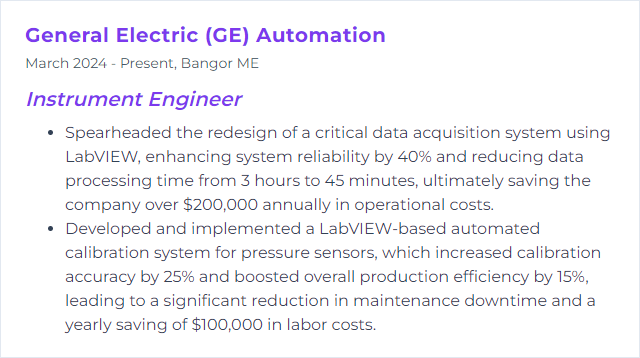
8. P&ID Interpretation
Interpreting P&IDs means reading the language of the process: equipment, piping, instruments, signals, and how they connect to control and safety.
Why It's Important
It ties design intent to field reality. Without it, troubleshooting is guesswork; with it, changes and startups move briskly and safely.
How to Improve P&ID Interpretation Skills
Standards and symbols: Learn ISA-5.1 and common symbology for instruments, valves, and line types.
Follow the flow: Trace the process—from feeds to products—and note pressure, temperature, and composition changes.
Control loops: Understand measurements, final elements, control strategies, interlocks, and failure actions.
Safety layers: Identify relief devices, shutdowns, alarms, and safeguards; know what trips what.
Simulations and walkdowns: Compare P&IDs to the field, redline discrepancies, and update as-builts.
Peer reviews: Review diagrams with operations, process, and maintenance—fresh eyes catch mismatches.
Keep learning: Courses on process control and instrumentation sharpen reading and context.
The more diagrams you trace, the faster you see hidden failure modes and better design choices.
How to Display P&ID Interpretation Skills on Your Resume
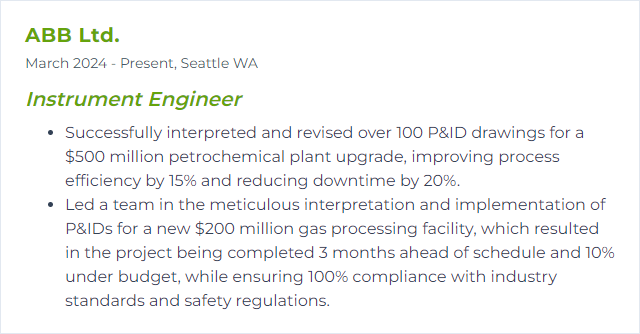
9. Fieldbus Protocols
Fieldbus protocols (Foundation Fieldbus, PROFIBUS, Modbus, and others) define how field devices and controllers talk—digital, deterministic, and rich with diagnostics.
Why It's Important
Standardized communication reduces wiring, boosts diagnostics, and simplifies integration across multi-vendor systems.
How to Improve Fieldbus Protocols Skills
Interoperability: Stick to current standards and certified devices; consistency saves commissioning time.
Network design: Choose topologies (ring, star, trunk-and-spur) suited to distance, redundancy, and maintenance needs.
Device management: Use FDT/DTM or EDDL tools to configure, diagnose, and maintain devices efficiently.
Security: Apply ISA/IEC 62443 guidance—segmentation, access control, and monitoring—especially over Ethernet-based protocols.
Data integration: Use OPC UA and a historian to move and store data cleanly for analytics.
Training: Formal vendor and association courses prevent common layout and configuration pitfalls.
Monitoring: Trend network health, error rates, and power levels to catch issues before devices drop.
Good design up front makes expansions painless later.
How to Display Fieldbus Protocols Skills on Your Resume
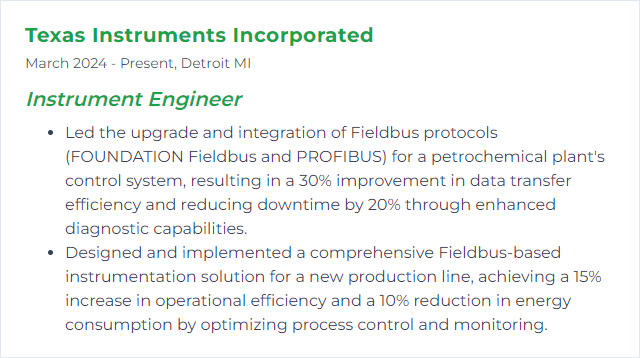
10. Instrument Calibration
Calibration compares an instrument’s output to a known reference and adjusts it so measurements stay true.
Why It's Important
Accurate measurement protects people, equipment, and product quality. Compliance and efficiency both depend on it.
How to Improve Instrument Calibration Skills
Set schedules: Define risk-based intervals that reflect criticality, usage, and drift history.
Traceable standards: Use standards traceable to national or international bodies (e.g., NIST).
Method discipline: Apply method-specific best practices for pressure, temperature, flow, and analytical instruments.
Environmental control: Calibrate under stable conditions; temperature and humidity matter.
Documentation: Maintain complete records—methods, references, results, as-left/as-found—to meet ISO 9001 expectations.
Training: Keep technicians current on procedures, uncertainty, and safety.
Calibration software: Manage schedules, certificates, and trends with dedicated tools.
Preventive maintenance: Clean, inspect, and test instruments to reduce drift and downtime.
Verification and validation: Periodically verify procedures and reference standards per ISO/IEC 17025 principles.
Continuous improvement: Analyze trends; shorten intervals where drift is high, extend where stability is proven.
Trustworthy numbers come from discipline—before, during, and after the calibration itself.
How to Display Instrument Calibration Skills on Your Resume
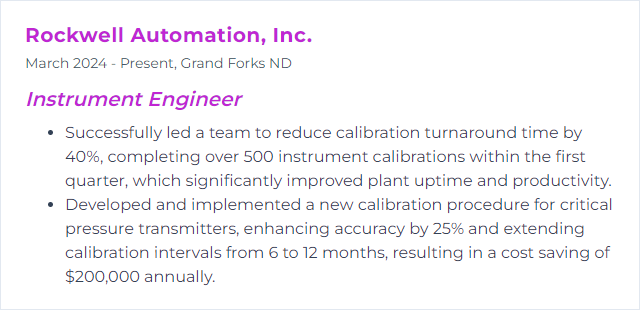
11. Signal Processing
Signal processing extracts meaning from noisy sensor data—filtering, transforming, and modeling to reveal what’s really happening in the process.
Why It's Important
Better signals mean better control. Diagnostics improve, false alarms fall, and maintenance becomes targeted instead of reactive.
How to Improve Signal Processing Skills
Fundamentals: Master sampling, aliasing, convolution, FFTs, and windowing.
Tools: Work in MATLAB or Python with NumPy, SciPy, and plotting libraries.
Filter design: Design FIR/IIR filters, understand stability and phase, and match filters to sensor physics.
Advanced methods: Explore wavelets, time-frequency analysis, and adaptive filtering for nonstationary signals.
Real data: Practice on plant histories and event logs; verify improvements against ground truth.
Keep up: Follow reputable technical societies and journals to adopt techniques that actually add value.
Noise never sleeps, but good processing keeps it quiet enough to work.
How to Display Signal Processing Skills on Your Resume
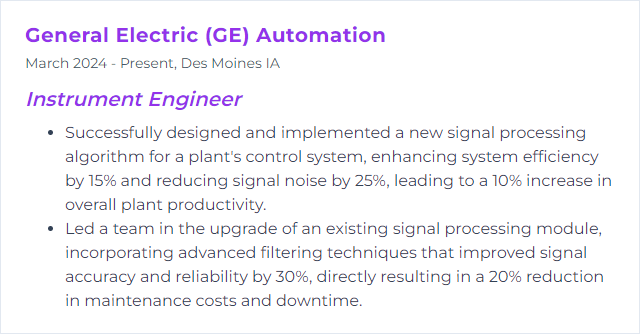
12. Safety Instrumented Systems
Safety Instrumented Systems (SIS) are independent layers of protection—hardware and software—that push a process to a safe state when predefined risk thresholds are crossed, in line with IEC 61508 and IEC 61511.
Why It's Important
They protect people, the environment, and assets when something goes wrong. When prevention fails, SIS mitigates.
How to Improve Safety Instrumented Systems Skills
Risk analysis: Perform hazard and risk assessments (HAZOP, LOPA) aligned with IEC 61511 and ISA 84.
Design for SIL: Assign appropriate SIL targets, apply fail-safe principles, separation, and redundancy where needed.
Verification and validation: Verify calculations (PFDavg, SFF) and validate functions under realistic scenarios before startup.
Maintenance and proof testing: Build test procedures and intervals that achieve required availability without excessive downtime.
Training and documentation: Maintain full lifecycle documentation and train personnel on cause-and-effect, bypass rules, and overrides.
Performance monitoring: Track demands, spurious trips, and test results; adjust strategies based on data.
Compliance culture: Keep procedures current with standards updates and run periodic functional audits.
Strong lifecycle management—not just good hardware—keeps SIS credible.
How to Display Safety Instrumented Systems Skills on Your Resume
